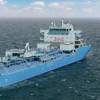The American Waterways Operators (AWO) and the U.S. Coast Guard released a study of barge/bridge allisions spanning 10 years. The study was conducted by the Coast Guard-AWO Bridge Allision Work Group, established last summer in the aftermath of fatal bargebridge accidents at South Padre Island, Texas in September 2001 and Webbers Falls, Oklahoma in May 2002. Based upon the findings, the Work Group report identified a five-point action plan to prevent bridge allisions and minimize the consequences of those that do occur. Key findings of the Work Group include:
• Bridge allisions involving towing vessels occur at the rate of about six allisions per 10,000 towing vessel trips.
• The overwhelming majority of bridge allisions - 94 % -- result in minor property damage with no personal injury or harm to the environment. However, as the I-40 and Queen Isabella Bridge allisions makes clear, serious accidents can occur. Since 1992, four bridge allision cases have resulted in fatalities.
• Fully 90% of towing vessel bridge allisions are related to human performance.
• Some 34% of the bridge allisions that occurred between 1992 and 2001 took place at bridges that have been identified by the Coast Guard as obstructions to navigation and candidates for alteration or removal under the authority of the Truman-Hobbs Act.
The Work Group's five-point action plan to reduce the likelihood of bridge allisions and limit the consequences of those that do occur includes these recommendations:
1.Implement prevention measures to improve decision making on the part of the navigator, including: identifying vulnerable bridges, developing safe transit procedures for vulnerable bridges, requiring sufficient local knowledge before navigating a vulnerable bridge, and implementing Crew Endurance Management Systems throughout the towing industry to enhance an operator's fitness for making good decisions.
2.Accelerate the removal and alteration of bridges under the authority and procedures of the Truman-Hobbs Act.
3.Consider additional protection for bridge piers for bridges identified as most vulnerable to allision, or to severe consequences should an allision occur.
4.Use the report as the basis for future studies by the Coast Guard Research and Development Center to further develop potential beneficial recommendations.
5.Initiate a special investigative effort for certain bridge allisions in which human factors issues were possible causal factors, in order to provide future analysts with more detailed information than is currently available.
Sponsored Content
Innovative Hull Maintenance: Profitable & Green

Subscribe for
Maritime Reporter E-News
Maritime Reporter E-News is the maritime industry's largest circulation and most authoritative ENews Service, delivered to your Email five times per week













